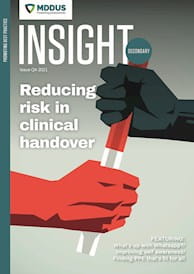 IT’S a vital part of good team work and safe patient care – but just how good is your handover?
IT’S a vital part of good team work and safe patient care – but just how good is your handover?
Team communication failure during care transfers has been flagged as a key risk area in a recent analysis of patient safety incidents in hospitals across England and Wales.
Mistakes can happen in any situation that involves a handover, but there is a significantly greater risk when patients are:
- handed over between day and night duty
- admitted into hospital
- transferred to a different ward.
Changing work patterns also impact on the continuity of care.
In our experience as MDDUS advisers, poor communication during handovers is a common factor in complaints, clinical negligence claims, and disciplinary or regulatory actions.
High risk
In a busy secondary care setting where clinical teams are under intense pressures, it is easy to see how crucial information may be missed. Handover failures are a major cause of preventable patient harm and can lead to delayed or wrong diagnoses, repeated or inappropriate investigations and incorrect treatment.
An efficient and accurate handover protects the patient, ensures continuity of care and allows doctors to prioritise workload according to clinical need.
Doctors have an obligation to communicate effectively with colleagues and to be satisfied that suitable arrangements are in place to ensure safe handover of patient care.
Getting it right
- A quiet place. Where possible, carry out your handover somewhere quieter/less hectic with fewer interruptions.
- Be clear. Avoid ambiguous language and don’t rush. Patients expect doctors to share relevant information effectively, so that their care is properly coordinated and managed.
- Keep it relevant. No one wants to receive an exhaustive summary for every patient, but they do need to know anything that may be important. Think about your own experiences on receiving a good/bad handover. What difference did it make to your shift? What additional information was helpful? How could it have been better?
- Never assume. You may think that someone else in the team will pass on information necessary for patient care, but double check. If you are the one handing over to a colleague, remember you are their primary source of information. Don’t rely on nursing or other staff members to act as your safety net. Like you, they can also get easily distracted with other responsibilities and it is not their job to ensure your work is carried out. Doctors have a duty to ensure they are clear about each individual’s responsibility for communicating information to members of the multidisciplinary team, as well as to patients and those close to them.
- Consider using a handover template. These can be a useful way of saving time while ensuring you don’t miss important information. Your hospital may have its own internal handover template which you can follow. Alternatively, organisations such as NICE, the RCP and other Royal Colleges have helpful toolkits and guidance on this area.
- Encourage team cooperation. In its guidance Leadership and management for all doctors, the General Medical Council (GMC) states that doctors should encourage team members to cooperate and communicate effectively and “if you identify problems arising from poor communication or unclear responsibilities within or between teams, you should take action to deal with them.”
- Consider formal training. Check if training is available within your organisation to improve communication skills, or the handover process more specifically.
- Take personal responsibility. A handover requires effective communication between at least two people. While you can’t control your colleagues and what they tell you, you can be responsible for what information you request and the environment in which you receive it.
Finding time to handover relevant patient information during a busy shift can be challenging but it is vital for safe patient care. Don’t rush your handover. Ensure the information you give is relevant, accurate and includes all the essential details.
This page was correct at the time of publication. Any guidance is intended as general guidance for members only. If you are a member and need specific advice relating to your own circumstances, please contact one of our advisers.
Read more from this issue of Insight Secondary

Save this article
Save this article to a list of favourite articles which members can access in their account.
Save to library
